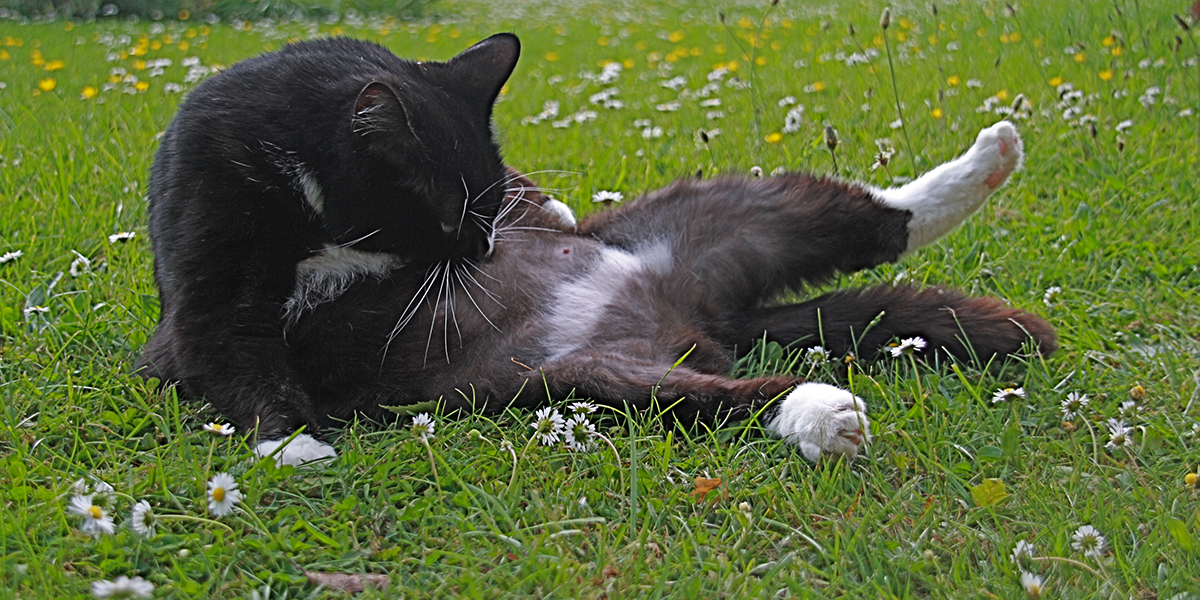Over-grooming refers to any behaviour that goes beyond normal grooming for coat maintenance and scent distribution. If your cat is over-grooming you will notice patches of broken or sparse hair, complete hair loss in areas and occasionally damage to the underlying skin. In extreme cases a cat may chew or bite, usually its feet or tail, causing trauma that may require, in the case of the tail, partial amputation. An affected cat may lick, chew, pluck or bite areas of hair or skin and the behaviour can be difficult to interrupt.
Is over-grooming stress-related?
The majority of cases of over-grooming in cats are initially caused by a skin or pain problem. However, it is commonly suggested that most cases also have a stress component.
Cats frequently use behaviour such as grooming, to make themselves feel better during stressful situations or when they are anxious. This can become compulsive if the grooming behaviour is performed out of context and so frequently that it disrupts normal activity. Some Oriental breeds, anecdotally, are more likely to develop purely stress-related grooming problems, often plucking the fur, but there is no conclusive evidence to suggest how common this is or why this should be the case.
See our information on anxious cats
What are the most common areas that a cat will over-groom?
Over-grooming can occur on any part of the body that the cat can reach with its tongue. The most common presentations are the belly, inside of the hind legs, the legs, front and back and across the flank. The patches can often appear symmetrical on either side of the body.
Over-grooming should be distinguished from genuine alopecia (described as the partial or complete absence of hair from areas of the body where it normally grows). The difference is that when hair is removed by deliberate grooming the remaining broken hair shafts feel spiky and sharp whereas in alopecia any remaining hair in the area feels soft and normal to touch.
Could over-grooming be a sign of illness?
There are a number of diseases that may result in over-grooming, often in response to intense itching or pain. Probably the most common cause is a hypersensitivity to flea saliva. Cats can also develop skin reactions to something in their diet or a number of other substances present in the environment. See fleas and flea control in cats and the itchy cat – when it is not fleas.
Feline lower urinary tract disease is a common problem in cats and this can cause pain and discomfort in the bladder and other parts of the urinary tract. Cats may, in response to this pain, over-groom in the localised area where the pain is – a common presentation would be a cat with a bald patch (or sparse hair) on its lower belly, the inside of its thighs and around its genitals.
Feline hyperaesthesia syndrome may be another possible differential. This is a poorly understood condition that manifests in various bizarre behaviours that include skin twitching and sudden bouts if intense grooming and self-mutilation, often of the hind feet and tail.
There are many other possible causes and your veterinarian will examine your cat and carry out any tests that may be necessary.
What should I do if my cat is over-grooming?
As with any other behaviour problem or sign of illness you should consult your veterinarian as soon as possible. Your cat will then be treated for any medical condition that is found but you may also be referred, if this is relevant to your cat’s situation, to a behaviourist who will identify and address any stressors which may have triggered or exacerbated the problem.
Thank you for visiting our website, we hope you have found our information useful.
All our advice is freely accessible to everyone, wherever you are in the world. However, as a charity, we need your support to enable us to keep delivering high quality and up to date information for everyone. Please consider making a contribution, big or small, to keep our content free, accurate and relevant.
Support International Cat Care from as little £3
Thank you.
Donate Now


